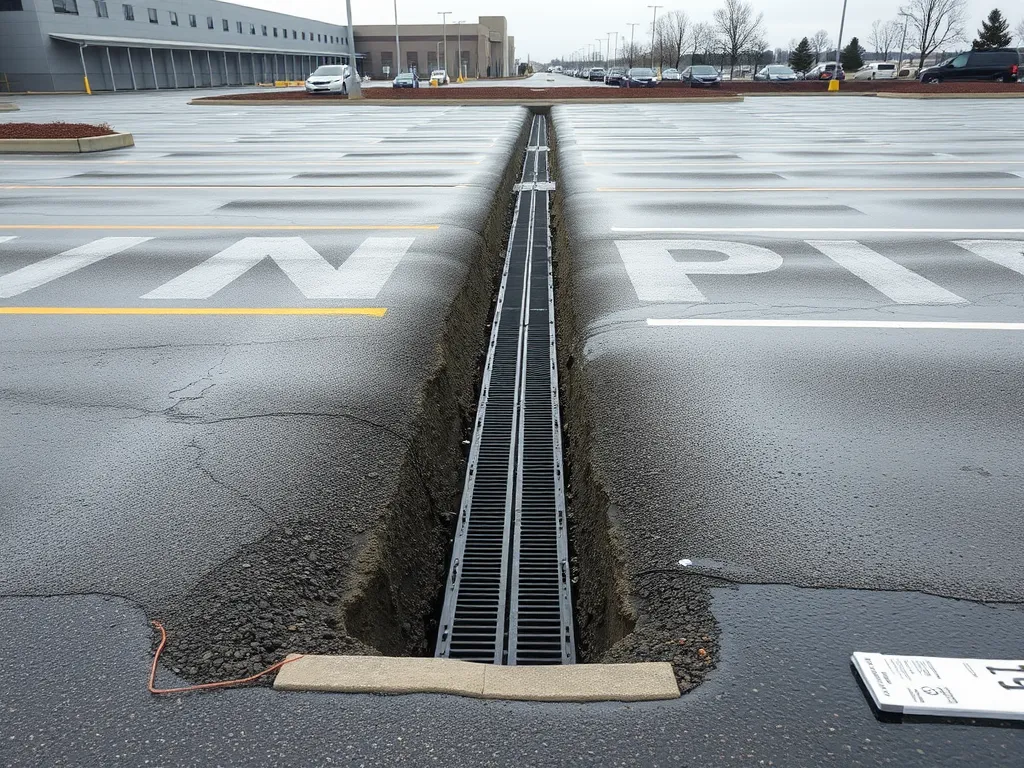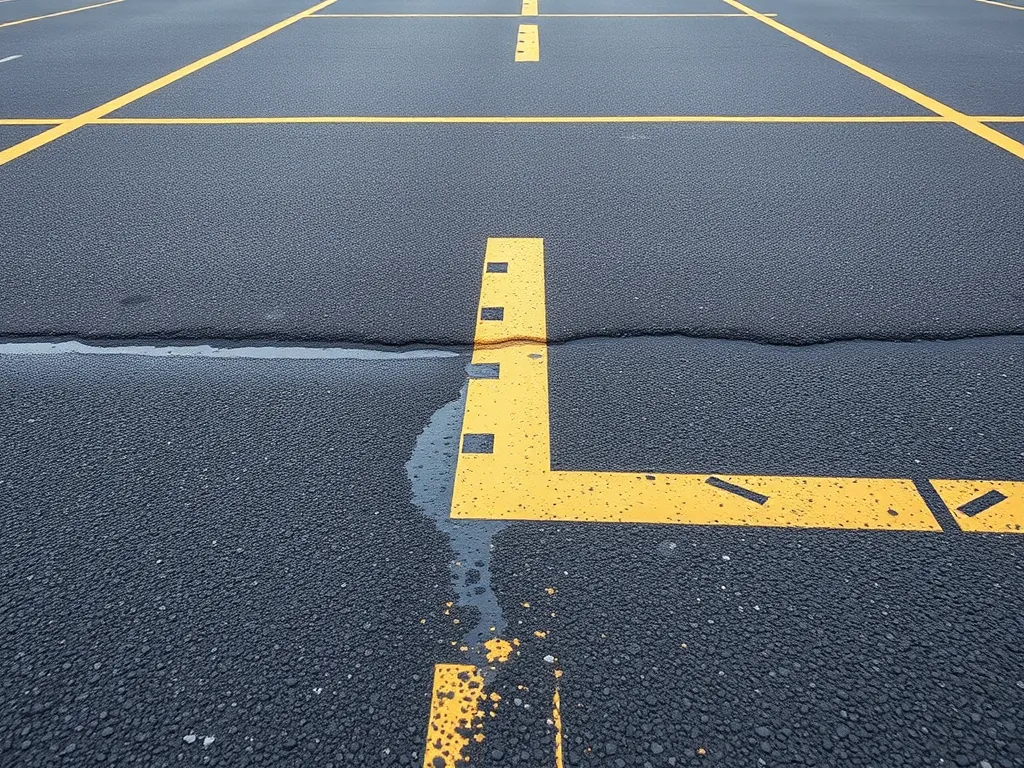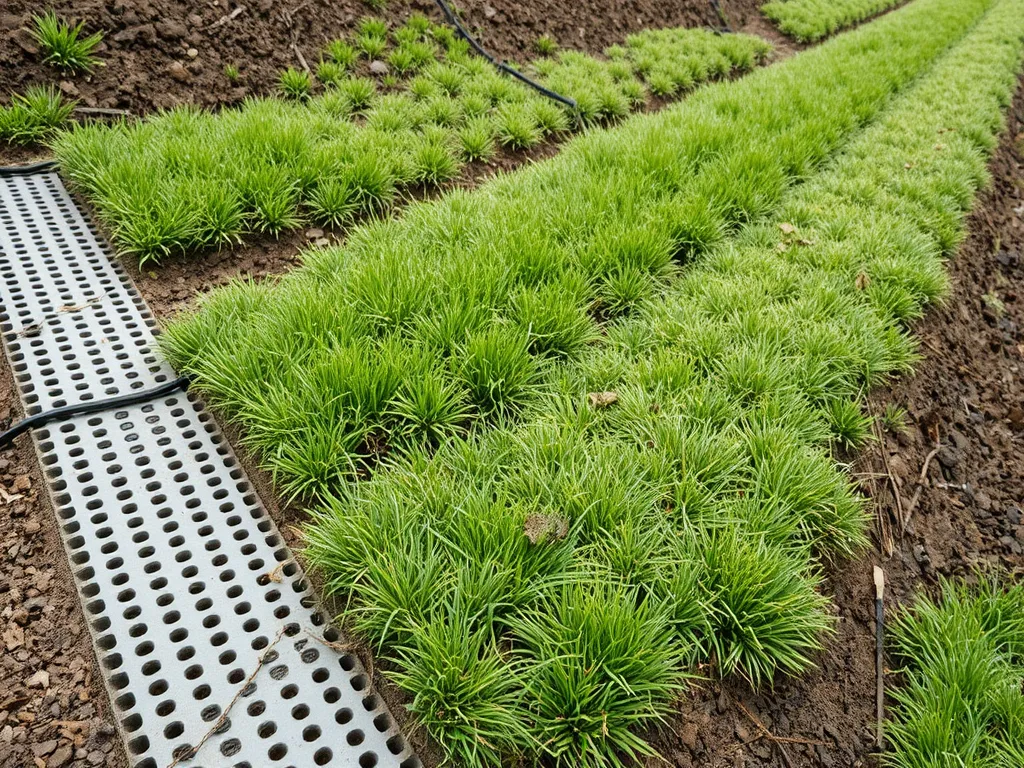Drainage Systems for Asphalt Surfaces: Design, Installation & Best Practices
Published on: November 21, 2025 | Last Updated: April 14, 2025
Written By: George Voss
Drainage systems for asphalt surfaces are engineered networks that channel water away from pavement using slopes, trenches, and underground pipes. Designed specifically for asphalt’s water-resistant properties, these systems prevent pooling by moving rainfall or meltwater quickly off the surface. Key types include sloped paving (surface), gravel-filled French drains (subsurface), curbside channels (edge), and catch basins (internal). Effective drainage stops cracks, extends pavement life by 15+ years, and reduces icy patches by 60% in cold climates.
This article explains how to choose and maintain asphalt drainage systems for driveways, roads, and parking lots. Get slope specifications (like the 2% minimum grade for parking areas), compare pipe materials (PVC vs. corrugated metal), and learn installation steps for trench drains handling 500+ gallons per minute. We’ll also cover EPA stormwater rules, cost-saving recycled materials, and fixing common issues like clogged grates or eroded edges.
Contents
- Why Asphalt Surface Drainage Systems Matter
- Types Of Asphalt Drainage Systems
- Design Considerations for Asphalt Drainage
- Installing Drainage Systems for Asphalt Surfaces
- Maintaining Asphalt Drainage Systems
- Environmental Considerations
- FAQs About Asphalt Surface Drainage
- Closing Thoughts
- Additional Resources for You:
Why Asphalt Surface Drainage Systems Matter
Water management separates functional asphalt from failing pavement. Without proper drainage, even high-grade PG 64-22 binder mixes degrade faster than their design life. Let’s break down three core reasons these systems demand attention.
Preventing Water Damage to Asphalt Pavements
Hydrostatic pressure cracks asphalt from below when water pools in base layers. One inch of standing water exerts 62.4 pounds per square foot – enough to lift pavement edges over time. Freeze-thaw cycles worsen this, expanding ice crystals by 9% in voids. Install crowning (1-2% slope) paired with edge drains to redirect 95% of surface water within 15 minutes of rainfall.
Enhancing Longevity Of Asphalt Surfaces
Pavements with working drainage last 20+ years versus 8-12 years for poorly drained surfaces (Asphalt Institute data). Subsurface French drains with 4-inch perforated PVC pipes protect aggregate bases from saturation. This maintains 90%+ compaction in crushed stone layers – critical for load distribution. Annual maintenance costs drop by $0.30 per square foot compared to reactive repairs.
Safety Benefits Of Effective Drainage
Standing water creates hydroplaning risks at speeds above 35 mph. Properly sloped lots (2% minimum) reduce skid potential by 40%. ADA-compliant designs require cross slopes under 2% to prevent wheelchair tipping – achievable through trench drains spaced every 20 feet. Catch basins with 12″x12″ grates handle 55 gallons per minute flow rates during storms.
With these impacts clear, the next step involves selecting the right drainage system types for your project’s needs.
Types Of Asphalt Drainage Systems
Effective water management requires matching system types to site needs. Four primary categories handle runoff at different pavement layers.
Surface Drainage Systems
These systems tackle water immediately after contact with pavement. Proper design prevents pooling and hydroplaning risks.
Crowned Surface Drainage Design
A 2-3% cross-slope peaks at the centerline, directing water to edges. Common on roads, this design moves 95% of rainfall within 15 minutes. ASTM E2832 specifies crown slope tolerances.
Gutter-Based Drainage Solutions
Galvanized steel or polymer concrete gutters collect runoff along paved edges. Pair with 6-12 inch curb openings spaced every 30-50 feet. Handles up to 7 gallons per minute per linear foot during storms.
Subsurface Drainage Systems
Buried components combat water infiltrating base layers. Critical for frost-prone regions.
French Drains for Asphalt Foundations
Perforated PVC pipes (4-6 inch diameter) wrapped in geotextile sit in gravel beds 12-18 inches below pavement. Handles 1-5 gallons per day per square yard, depending on soil permeability.
Perforated Pipe Networks
Grids of interconnected pipes beneath parking lots divert groundwater. Requires 6-8 inch aggregate backfill meeting AASHTO M43 specs. Reduces subgrade saturation by 40-60%.
Edge Drainage Systems
Perimeter controls prevent water from seeping into pavement seams.
Curbside Channel Drains
Stainless steel linear drains along asphalt edges process 25-50 liters per second. Install with 1/8″ per foot slope toward main collection points. Grates meet ANSI/NAAMM MBG 531 load ratings.
Swale Integration with Asphalt Edges
Grassed swales with 2:1 side slopes blend with paved surfaces. Moves water 3x slower than concrete channels, allowing natural infiltration. Requires 6-foot minimum width for maintenance access.
Internal Drainage Systems
In-pavement features intercept water mid-surface.
Catch Basin Configurations
Precast concrete basins (18×18 inch to 36×36 inch) connect to 8-12 inch drain lines. Position every 75-100 feet in parking lots. Include sump areas to trap sediment.
Trench Drain Applications
Linear polymer concrete drains handle heavy flows across driveways. Specify H-20 load-rated grates for vehicle areas. Slope trench beds 1/4 inch per foot toward outlets.
Proper system selection sets the stage for effective water management. Next, we’ll break down key design factors that ensure these components work seamlessly with asphalt surfaces.

Design Considerations for Asphalt Drainage
Effective drainage systems for asphalt surfaces require precise engineering. Proper design prevents costly repairs while meeting local building codes.
Optimal Slope Requirements for Asphalt
Slope design directs water flow while maintaining structural stability. Industry standards vary based on surface type and use.
Parking Lot Slope Standards
Parking lots need 1-2% slopes (1/8″ to 1/4″ per foot) to prevent ponding. Cross-slope designs route water toward grated inlets or perimeter swales. The Federal Highway Administration mandates minimum 1% grades near disabled parking zones.
Roadway Gradient Specifications
Roads use 1.5-3% slopes (2-4 inches per 10 feet) for rapid runoff. Curved sections often incorporate superelevation (banked turns) up to 6% to combat centrifugal water buildup. State DOTs typically require 0.3% minimum longitudinal grades on highways.
Balancing Flatness and Drainage Efficiency
Surfaces with slopes under 0.5% risk ponding, while grades over 5% cause erosion. Laser-guided screeding during paving maintains 0.75-1.5% cross slopes in most cases. Permeable asphalt mixes (18-21% void spaces) supplement low-slope designs.
Material Selection for Drainage Components
Component Type | Specification | Purpose HDPE Pipes | 4-12″ diameter, 46 PSI rating | Subsurface water transport Geotextile Fabric | 4 oz/sq yd, 100% polypropylene | Filter soil particles Polymer-Coated Aggregates | 1.5-2.5″ crushed stone | Prevent pipe clogging
Corrugated metal pipes (CMP) work for low-budget projects but rust within 15-20 years. PVC trench drains (6-8″ width) handle up to 7.5 gallons per minute flow rates in commercial lots.
With design elements locked in, the next phase focuses on turning plans into paved reality through precise installation methods.
Also See: Economic Analysis Of Asphalt Recycling Impacts
Installing Drainage Systems for Asphalt Surfaces
Proper installation ensures drainage systems for asphalt surfaces work as designed. Follow these critical steps to merge water management with pavement performance.
Step 1: Site Preparation and Grading
Clear vegetation and debris from the work area. Use laser-guided graders to create a 1.5-2% cross-slope for surface drainage asphalt surfaces. Verify elevations match engineered plans, accounting for subsurface utility lines. Compact subgrade to 90% Proctor density to prevent settling.
Step 2: Base Layer Construction
Spread 6-12 inches of open-graded crushed stone (ASTM D448 #57). This porous layer directs water away from asphalt drainage system components. Achieve 95% compaction with vibratory rollers. Test permeability rates (≥ 200 in/hr) to confirm proper water flow.
Step 3: Drainage Structure Placement
Position catch basins every 50-75 feet along low points. Embed trench drains 1/8″ below planned asphalt surface elevation. Connect 4-6″ perforated pipes (PVC or HDPE) with 2% minimum slope to outlet points. Backfill around structures with washed gravel to prevent clogging.
Step 4: Asphalt Surface Integration
Apply tack coat (0.05 gal/sy) to bond base and asphalt layers. Lay PG 64-22 mix at 280-325°F in 2-4″ lifts. Form smooth transitions around drains using hand tools. Maintain 1/4″ per foot slope toward drainage for asphalt surfaces water collection points.
Step 5: Final Slope Verification
Survey finished surface with laser levels to confirm 1-3% gradients. Test flow rates by spraying 5 gallons/minute across 10-foot sections. Adjust any areas with ponding exceeding 1/8″ depth within 15 minutes.
With drainage systems asphalt surfaces properly installed, focus shifts to preserving their function over time. The next phase covers maintenance strategies that protect both pavement and water management features.

Maintaining Asphalt Drainage Systems
Keep asphalt drainage systems working well to stop water harm and make surfaces last longer. Three key steps keep water flow smooth.
Regular Debris Removal Techniques
Clear leaves, dirt, and trash from drains and channels. Use brooms, vacuum trucks, or pressure washers. Aim for quarterly clean-ups or after big storms. Clogged drains cause water to pool, crack asphalt, and weaken bases. For surface drainage asphalt systems, check grates and swales twice a year.
| Tool | Cost Range | Use Case |
|---|---|---|
| Pressure Washer | $0.10-$0.30/sq ft | Cleaning grates, gutters |
| Vacuum Truck | $200-$400/hr | Pipe blockages |
Inspecting Drainage Structure Integrity
Check catch basins, pipes, and curbside channels for cracks or rust. Look for loose joints in French drains or slumped soil near swales. Use CCTV cameras to scan pipes wider than 12 inches. Fix small gaps with epoxy fillers to stop soil leaks. Drainage system asphalt surfaces need checks each spring after freeze-thaw cycles.
Repairing Asphalt Around Drainage Features
Seal cracks near drains within 48 hours to stop water seepage. Use PG 64-22 binder for patches in wet zones. If potholes form near trench drains, mill 6 inches deep and repave with hot mix. Edge drains need 2% slope checks post-repair. For asphalt surface drainage design, match new pours to old grade lines to keep flow paths intact.
Pro care cuts flood risks and adds 5-8 years to pavement life. Now, let’s explore how eco-friendly methods boost drainage for asphalt surfaces.
Environmental Considerations
Effective drainage systems for asphalt surfaces must balance pavement protection with ecological responsibility. Modern designs now prioritize solutions that manage stormwater while minimizing environmental impact.
Sustainable Water Management Practices
Permeable asphalt surfaces – mixes with 16-22% void spaces – allow 5-7 inches of water absorption per hour. These porous pavements reduce stormwater runoff by up to 30% compared to traditional asphalt. Many projects pair them with bioswales (grassy channels with 2:1 slope ratios) that filter 40-60% of total suspended solids from runoff. EPA-compliant designs often integrate underground retention chambers that slowly release treated water into soil, replenishing groundwater supplies. Some municipalities offer 15-20% cost offsets for projects meeting LEED stormwater management criteria.
Erosion Control for Asphalt-adjacent Areas
Unchecked runoff from asphalt surfaces erodes 2-5 tons of soil per acre annually. Strategic placement of riprap (1.5-3 inch angular stones) along drainage paths reduces erosion rates by 60-75%. Contractors install geotextile fabric beneath riprap layers to prevent soil migration while maintaining 0.5-1.5 ft³/s water flow capacity. For slopes steeper than 3:1, reinforced turf mats with native grass roots stabilize soil within 8-12 months post-installation. NPDES regulations require sediment basins with minimum 3,600 cubic feet capacity for projects exceeding 1 acre of paved surface.
These ecological strategies create drainage systems that protect both asphalt integrity and surrounding landscapes. Up next: practical solutions for keeping these systems functioning at peak performance.

FAQs About Asphalt Surface Drainage
What Are the Benefits Of Installing a Drainage System Under Asphalt Surfaces?
Installing a drainage system under asphalt surfaces helps to alleviate hydrostatic pressure, prevents water from pooling, reduces the risk of cracking and structural failure, enhances the longevity of the pavement, and improves overall safety by minimizing the potential for hydroplaning.
How Often Should I Maintain My Asphalt Drainage System?
It’s recommended to conduct maintenance checks on your asphalt drainage system at least twice a year, ideally in the spring and fall, as well as after heavy storms. Regular maintenance includes debris removal and structural inspections to ensure optimal functionality.
Can a Drainage System Improve the Performance During Winter Weather?
Yes, an effective drainage system can significantly enhance performance during winter weather by reducing the accumulation of water that can freeze on the pavement. This helps to lower icy conditions and the risk of accidents.
What Signs Indicate That My Asphalt Drainage System Needs Repairs?
Signs that your asphalt drainage system may need repairs include persistent pooling of water on the surface, visible cracks or sinking around drainage structures, gurgling sounds in pipes, and excessive sediment build-up in catch basins or drains.
Are There Regulations I Need to Follow When Installing a Drainage System?
Yes, there are often local building codes and regulations regarding stormwater management and drainage systems that must be followed when installing a drainage system for asphalt surfaces. It’s important to check with local authorities to ensure compliance.
What is the Cost Range for Installing an Asphalt Drainage System?
The cost for installing an asphalt drainage system can vary widely depending on factors such as the type of drainage system, materials used, site conditions, and labor costs. On average, installation costs can range from $1,500 to over $5,000, but it is advisable to obtain quotes from multiple contractors for a precise estimate.
Closing Thoughts
Effective drainage systems for asphalt surfaces are vital for protecting pavements from water damage and enhancing their lifespan. By carefully choosing and implementing the right drainage solutions, you can significantly improve safety and reduce maintenance costs.
From surface drainage designs like crowned surfaces and gutters to subsurface solutions such as French drains, every component plays a critical role in water management. Paying attention to design considerations, installation steps, and ongoing maintenance ensures optimal performance.
For more in-depth information on asphalt drainage systems and related topics, visit Asphalt Calculator USA.
Additional Resources for You:
- Huang, Y. H. (2004). Pavement Analysis and Design (2nd ed.). Upper Saddle River, NJ: Pearson/Prentice Hall.
- Driveway Drainage Solutions | EastCoat Pavement Services
- Why Proper Drainage Matters in Asphalt Paving – Bennett Paving
- » Pavement Drainage
- Surface Drainage – Pavement Interactive


